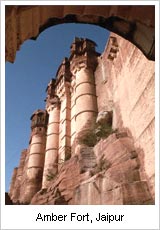 Introduction: Introduction:
Just 11 kms from Jaipur, Amber fort is a
splendid fort constructed in a scenic locale. Being a perfect
blend of Hindu and Muslim architecture, Jaipur attracts travellers
from around the globe. Built in 16 the century by Raja Man
Singh, the fort stands as a proud reminder of the exotic building
skills of the artisans of the yesteryears. This fort from
yore days unfurls the legacies of the time when the august
rulers imagined the unmatched craftmanship. Made up of red
sand stone and white marble, the Jaipur Amber fort palace
presents a picturesque site. Covering the interior walls of
the palace are painting scenes with carvings, precious stones
and mirror settings. The Maota Lake, in the foreground of
the court, offers an amazing sight. There are four sections
in the Amber fort. Leading up to the palace is the main stairway
situated in Jaleb Chowk, the main courtyard. Jaleb Chowk also
served as the area for welcoming the armies returning after
winning. The main gate that leads to the Jaleb Chowk is known
as Surajpol.
Other attractions of the Amer palace of Rajasthan
include:
Shila Mata Temple
Entry into Shila Mata Temple is through Singh Pol. The temple
is devoted to Shila Mata ( Goddess Kali), the goddess of victory
and houses a black marble idol of the goddess which was brought
here from Jessore by Raja Man Sigh in 1604. You would find
nine images of Goddess Durga (strength) and ten forms of Goddess
Saraswati ( knowledge) which are carved on the silver gates
of the temple. The mandap of this temple is made up of white
marble contrasting the colours of the idols.
Diwan-i-Khas (Hall of Private Audience)
Diwan-i-Khas show cases a rich amalgam of Rajput and Mughal
architecture. The architecture is showcased in the fascinating
Diwan-i-khas, Sukh Niwas, Jai Mandir and Jas Mandir. Decorated
with beautiful mirror work, Diwan -I - Khas has wonderful
carvings on the walls and the ceilings. The major attractions
of these halls are miniature murals made of coloured glasses
which depicts Radha and Krishna.
Diwan-i-Am or Hall of Public Audience
This is a delicate palace which you would come across on your
travel to Amber fort. This forty pillared pavillion is perfect
example of intricate craftmanship and was constructed by Mirza
Raja Jai Singh. The pavilion worked as a place where Maharajahs
used to recieve its general public and used to hear their
pertaining problems. The southern area of this palace was
kept clear so that the royal ladies could watch the proceedings
of Diwan-I-Am from the Zenana house ( Women's quarters).
Zenana
The fourth courtyard houses Zenana, the palace of the women.
A common corridor connects all the rooms of the alace. This
was done to provide privacy to the Maharaja while visiting
his Queens.
Sukh Niwas
Sukh Niwas was the pleasurable residence of the Maharaja.
For the purpose of cooling the palace, a channel for water
flow was laid in the palace. The palace also has an ivory
inlaid sandalwood door.
Ganesh Pol & Suhaag Mandir
Ganesh Pol forms another attractions in Amber fort and is
an imposing gateway which lies south of Diwan-i-am. The gateway
has been painted beautifully and endorse typical Rajasthani
motifs. From Ganesh Pol, you can move to beautiful garden
or Charbagh, which is based on the Mughal patten of gardens.
Jai Mandir
Behind the exquisite Ganesh Pol, a gate, are the residential
apartments of the Maharaja. Amongst them, is the Jai Mandir,
the hall of victory. It is known for its inlaid panel and
dazzling mirror ceiling.
|

